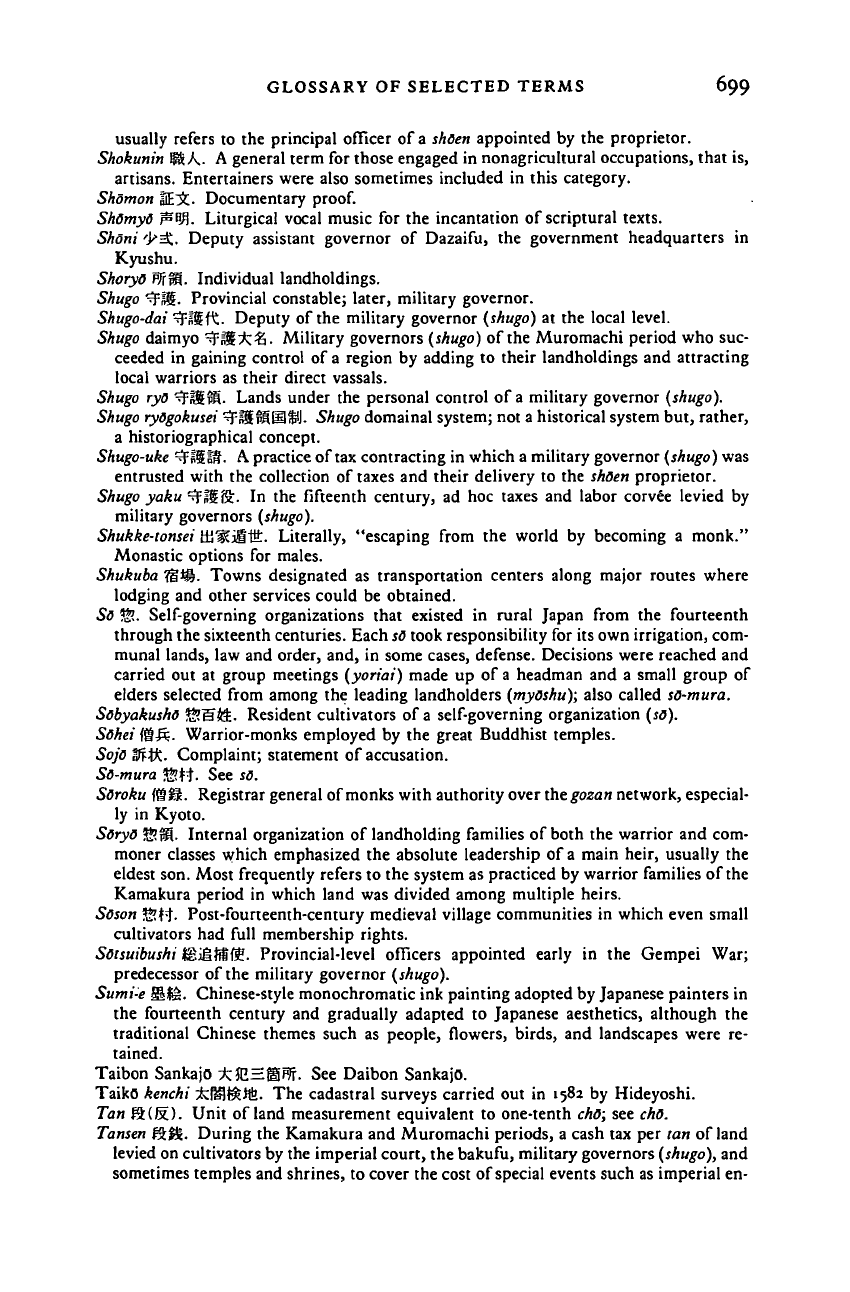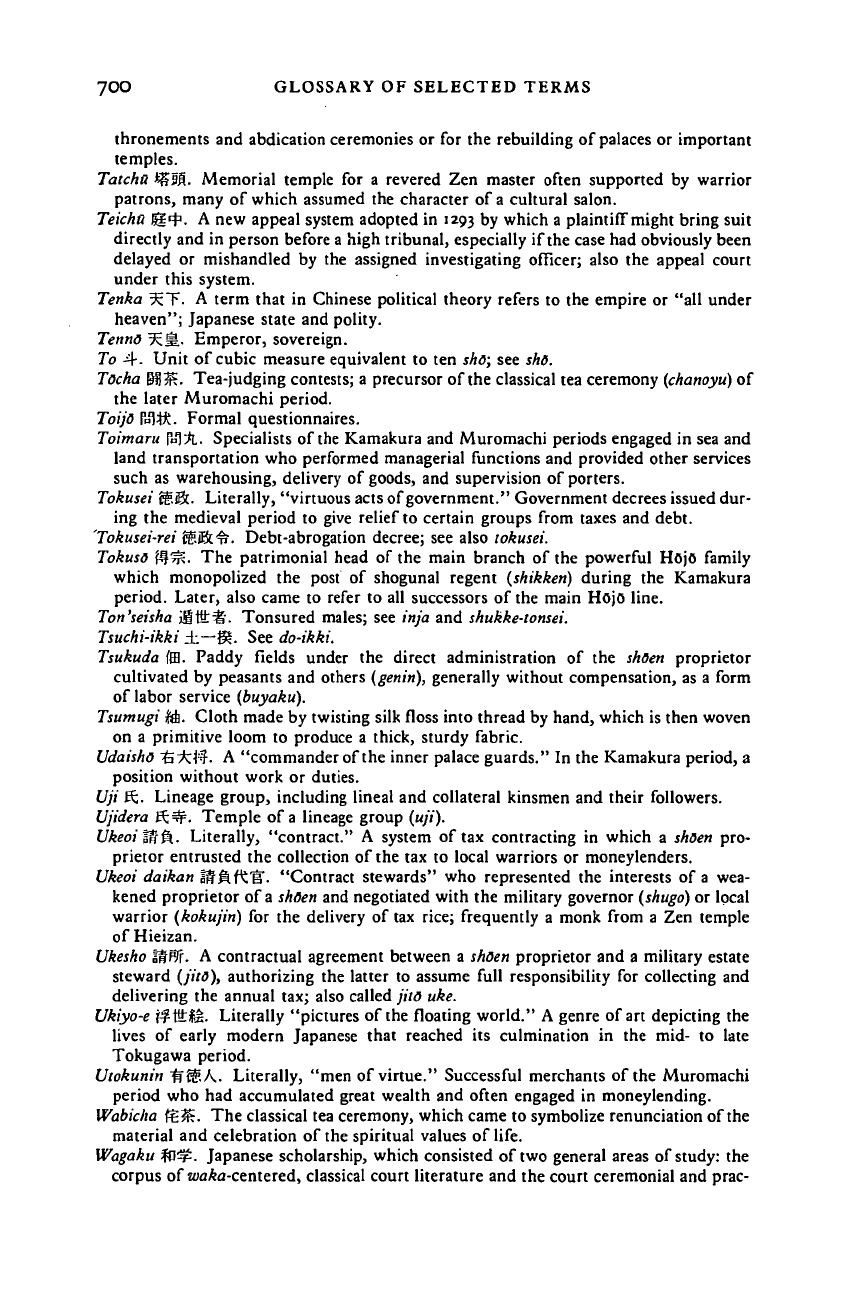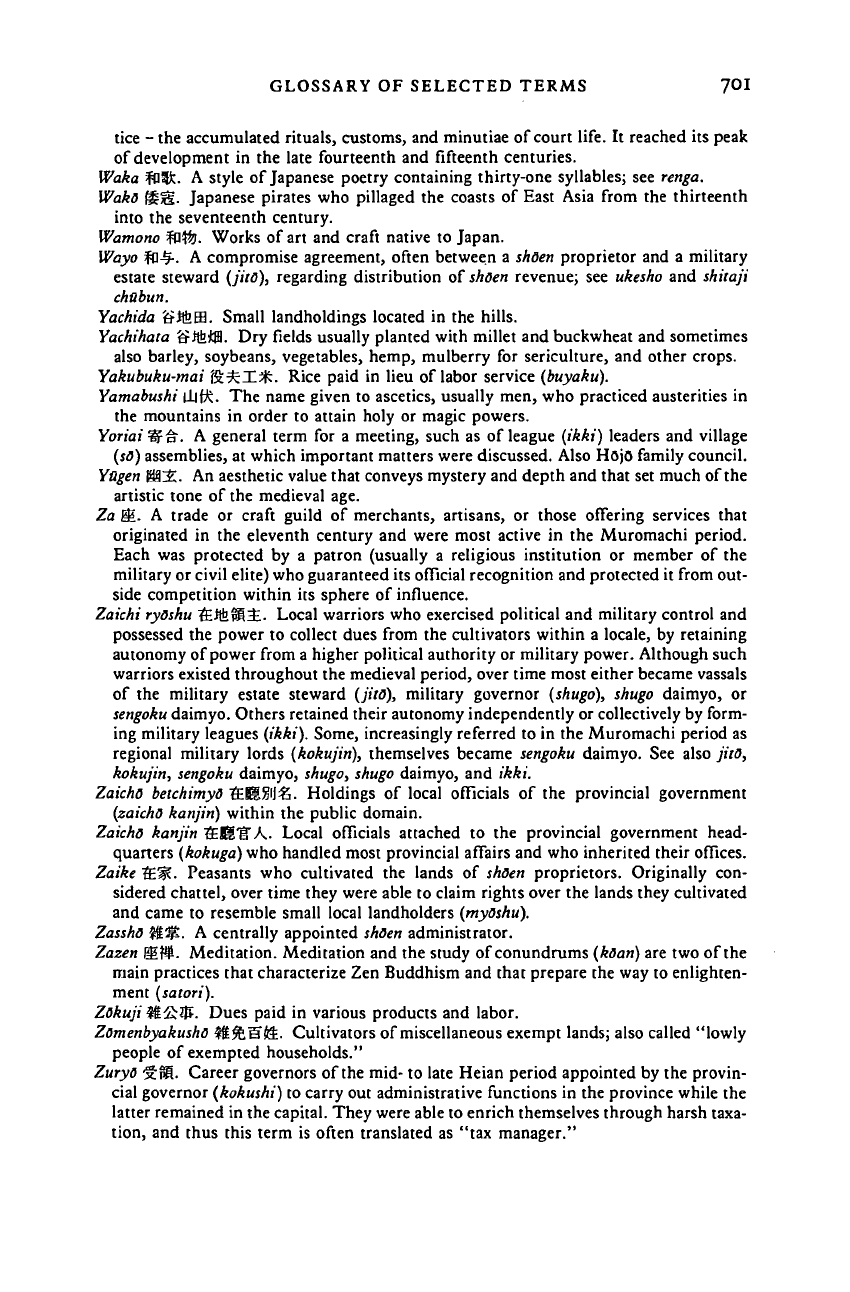The Cambridge History of Japan, Vol. 3: Medieval Japan
Подождите немного. Документ загружается.


GLOSSARY
OF
SELECTED TERMS
699
usually refers
to the
principal officer
of
a
shoen
appointed
by the
proprietor.
Shokunin
5$ A.
A
general term
for
those engaged
in
nonagricultural occupations, that
is,
artisans.
Entertainers were also sometimes included
in
this category.
Shomon tE^fc. Documentary
proof.
ShOmyO
pvft. Liturgical vocal music
for the
incantation
of
scriptural texts.
Shoni
'>^.
Deputy assistant governor
of
Dazaifu,
the
government headquarters
in
Kyushu.
Shoryo
WrM.
Individual landholdings.
Shugo
TFfflf.
Provincial constable; later, military governor.
Shugo-dai
^fMfi. Deputy
of the
military governor (shugo)
at the
local level.
Shugo daimyo ^fM^^i- Military governors (shugo)
of
the Muromachi period
who suc-
ceeded
in
gaining control
of a
region
by
adding
to
their landholdings
and
attracting
local warriors
as
their direct vassals.
Shugo ryo
^fMM-
Lands under
the
personal control
of
a military governor (shugo).
Shugo
ryOgokusei
^5$PIII1$IJ.
Shugo domainal system;
not a
historical system
but,
rather,
a historiographical concept.
Shugo-uke
^sllff. A
practice of tax contracting
in
which
a
military governor
(shugo)
was
entrusted with
the
collection
of
taxes
and
their delivery
to the
shoen
proprietor.
Shugo yaku ^fM'&.
In the
fifteenth century,
ad hoc
taxes
and
labor corvSe levied
by
military governors (shugo).
Shukke-tonsei tii^iiifi:. Literally, "escaping from
the
world
by
becoming
a
monk."
Monastic options
for
males.
Shukuba
?|*g.
Towns designated
as
transportation centers along major routes where
lodging
and
other services could
be
obtained.
So
3g.
Self-governing organizations that existed
in
rural Japan from
the
fourteenth
through
the
sixteenth centuries. Each
so
took responsibility
for its own
irrigation,
com-
munal lands,
law and
order,
and, in
some cases, defense. Decisions were reached
and
carried
out at
group meetings (yoriai) made
up of
a headman
and a
small group
of
elders selected from among
the
leading landholders
(myOshu);
also called
sO-mura.
Sobyakusho JSlfii. Resident cultivators
of
a self-governing organization
(so).
Sohei <Sft. Warrior-monks employed
by the
great Buddhist temples.
Sojo Drtt. Complaint; statement
of
accusation.
So-mura
®M. See so.
Soroku (SIS. Registrar general of monks with authority over the
gozan
network, especial-
ly
in
Kyoto.
SoryO
**»j!3.
Internal organization
of
landholding families
of
both
the
warrior
and com-
moner classes which emphasized
the
absolute leadership
of
a main heir, usually
the
eldest
son.
Most frequently refers
to the
system
as
practiced
by
warrior families
of
the
Kamakura period
in
which land
was
divided among multiple heirs.
Soson
*&M-
Post-fourteenth-century medieval village communities
in
which even small
cultivators
had
full membership rights.
Sotsuibushi IgiUffifjS. Provincial-level officers appointed early
in the
Gempei
War;
predecessor
of
the military governor (shugo).
Sumi
:
e SISc. Chinese-style monochromatic
ink
painting adopted
by
Japanese painters
in
the fourteenth century
and
gradually adapted
to
Japanese aesthetics, although
the
traditional Chinese themes such
as
people, flowers, birds,
and
landscapes were
re-
tained.
Taibon SankajO
-kW.=-Wf\-
See
Daibon Sankajo.
TaikO kenchi ^C^^Jfe.
The
cadastral surveys carried
out in 1582 by
Hideyoshi.
Tan S(J5). Unit
of
land measurement equivalent
to
one-tenth
chO;
see cho.
Tansen
f£g£. During
the
Kamakura
and
Muromachi periods,
a
cash
tax per tan of
land
levied
on
cultivators
by the
imperial court,
the
bakufu, military governors
(shugo),
and
sometimes temples
and
shrines,
to
cover
the
cost of special events such
as
imperial
en-
Cambridge Histories Online © Cambridge University Press, 2008

7OO GLOSSARY OF SELECTED TERMS
thronements and abdication ceremonies or for the rebuilding of palaces or important
temples.
Tatcha *gll. Memorial temple for a revered Zen master often supported by warrior
patrons, many of which assumed the character of a cultural salon.
Teichtt H4
1
. A new appeal system adopted in 1293 by which a plaintiff might bring suit
directly and in person before a high tribunal, especially if the case had obviously been
delayed or mishandled by the assigned investigating officer; also the appeal court
under this system.
Tenka 5cT. A term that in Chinese political theory refers to the empire or "all under
heaven"; Japanese state and polity.
Tenno ^^. Emperor, sovereign.
To 4-. Unit of cubic measure equivalent to ten sho; see sho.
Tocha BS3?. Tea-judging contests; a precursor of the classical tea ceremony
(chanoyu)
of
the later Muromachi period.
Toijo Fpitt. Formal questionnaires.
Toimaru PnTA. Specialists of the Kamakura and Muromachi periods engaged in sea and
land transportation who performed managerial functions and provided other services
such as warehousing, delivery of goods, and supervision of porters.
Tokusei $•.&. Literally, "virtuous acts of government." Government decrees issued dur-
ing the medieval period to give relief to certain groups from taxes and debt.
Tokusei-rei ffijBt^. Debt-abrogation decree; see also tokusei.
TokusO
{#^. The patrimonial head of the main branch of the powerful HojO family
which monopolized the post of shogunal regent (shikken) during the Kamakura
period. Later, also came to refer to all successors of the main HojO line.
Ton'seisha
j!iiS:^5\
Tonsured males; see inja and shukke-tonsei.
Tsuchi-ikki
±—Sk.
See do-ikki.
Tsukuda fffl. Paddy fields under the direct administration of the sheen proprietor
cultivated by peasants and others (genin), generally without compensation, as a form
of labor service (buyaku).
Tsumugi jfi. Cloth made by twisting silk floss into thread by hand, which is then woven
on a primitive loom to produce a thick, sturdy fabric.
Udaisho
~&iz¥}.
A "commander of the inner palace guards." In the Kamakura period, a
position without work or duties.
Uji K;. Lineage group, including lineal and collateral kinsmen and their followers.
Ujidera ft#. Temple of a lineage group
(uji).
Ukeoi Wift. Literally, "contract." A system of tax contracting in which a shoen pro-
prietor entrusted the collection of the tax to local warriors or moneylenders.
Ukeoi daikan KfftftTlT. "Contract stewards" who represented the interests of a wea-
kened proprietor of
a shoen
and negotiated with the military governor
(shugo)
or local
warrior (kokujin) for the delivery of tax rice; frequently a monk from a Zen temple
of Hieizan.
Ukesho
Ifffif.
A contractual agreement between a shoen proprietor and a military estate
steward (jito), authorizing the latter to assume full responsibility for collecting and
delivering the annual tax; also called jito uke.
Ukiyo-e
ffi-Vkife..
Literally "pictures of the floating world." A genre of art depicting the
lives of early modern Japanese that reached its culmination in the mid- to late
Tokugawa period.
Utokunin WSSA. Literally, "men of virtue." Successful merchants of the Muromachi
period who had accumulated great wealth and often engaged in moneylending.
Wabicha f£3S. The classical tea ceremony, which came to symbolize renunciation of the
material and celebration of the spiritual values of life.
Wagaku ft}^. Japanese scholarship, which consisted of two general areas of study: the
corpus of aiafoj-centered, classical court literature and the court ceremonial and prac-
Cambridge Histories Online © Cambridge University Press, 2008

GLOSSARY OF SELECTED TERMS 701
tice - the accumulated rituals, customs, and minutiae of court life. It reached its peak
of development in the late fourteenth and fifteenth centuries.
Waka WD;. A style of Japanese poetry containing thirty-one syllables; see renga.
Wako g|*I. Japanese pirates who pillaged the coasts of East Asia from the thirteenth
into the seventeenth century.
Wamono
fd!$j.
Works of art and craft native to Japan.
Wayo
fP-^-.
A compromise agreement, often between a
shoen
proprietor and a military
estate steward (yi'ffl), regarding distribution of
shoen
revenue; see ukesho and shitaji
chubun.
Yachida SJfeffl. Small landholdings located in the hills.
Yachihata SUfeflB. Dry fields usually planted with millet and buckwheat and sometimes
also barley, soybeans, vegetables, hemp, mulberry for sericulture, and other crops.
Yakubuku-mai S^I^. Rice paid in lieu of labor service (buyaku).
Yamabushi Ujftc. The name given to ascetics, usually men, who practiced austerities in
the mountains in order to attain holy or magic powers.
Yoriai%^5. A general term for a meeting, such as of league (ikki) leaders and village
(so) assemblies, at which important matters were discussed. Also HojO family council.
Yagen W&. An aesthetic value that conveys mystery and depth and that set much of the
artistic tone of the medieval age.
Za
HE.
A trade or craft guild of merchants, artisans, or those offering services that
originated in the eleventh century and were most active in the Muromachi period.
Each was protected by a patron (usually a religious institution or member of the
military or civil elite) who guaranteed its official recognition and protected it from out-
side competition within its sphere of influence.
Zaichi
ryOshu
tEJte?3i. Local warriors who exercised political and military control and
possessed the power to collect dues from the cultivators within a locale, by retaining
autonomy of power from a higher political authority or military power. Although such
warriors existed throughout the medieval period, over time most either became vassals
of the military estate steward (jito), military governor (shugo), shugo daimyo, or
sengoku
daimyo. Others retained their autonomy independently or collectively by form-
ing military leagues (ikki). Some, increasingly referred to in the Muromachi period as
regional military lords (kokujin), themselves became sengoku daimyo. See also jito,
kokujin, sengoku daimyo, shugo,
shugo
daimyo, and ikki.
Zaicho
betchimyO
liEBSSiJ^i. Holdings of local officials of the provincial government
(zaicho kanjin) within the public domain.
Zaicho kanjin ~&M*g A. Local officials attached to the provincial government head-
quarters (kokuga) who handled most provincial affairs and who inherited their offices.
Zaike
~&%.
Peasants who cultivated the lands of shoen proprietors. Originally con-
sidered chattel, over time they were able to claim rights over the lands they cultivated
and came to resemble small local landholders (myOshu).
Zassho %%• A centrally appointed
shoen
administrator.
Zazen W&. Meditation. Meditation and the study of conundrums (koan) are two of the
main practices that characterize Zen Buddhism and that prepare the way to enlighten-
ment (satori).
Zokuji $lfi$. Dues paid in various products and labor.
Zomenbyakusho Jtfelifii. Cultivators of miscellaneous exempt lands; also called "lowly
people of exempted households."
Zuryo
•jtvU.
Career governors of the mid- to late Heian period appointed by the provin-
cial governor (kokushi) to carry out administrative functions in the province while the
latter remained in the capital. They were able to enrich themselves through harsh taxa-
tion, and thus this term is often translated as "tax manager."
Cambridge Histories Online © Cambridge University Press, 2008
